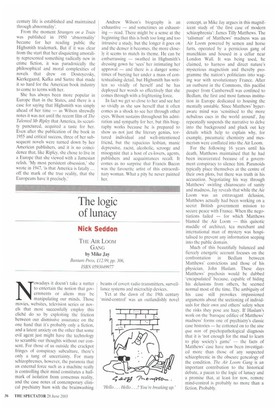The logic of lunacy
Nick Seddon
THE AIR Loom GANG by Mike Jay
Bantam Press. £12.99, pp. 306, ISBN 0593049977
Nowadays it doesn't take a nutter to entertain the notion that governments or aliens may be manipulating our minds. Those movies, websites, television series or novels that most successfully employ this cliché do so by exploiting the friction between our dismissive assurance on the one hand that it's probably only a fiction, and a latent anxiety on the other that some evil agent just might have the technology to scramble our thoughts without our consent. For those of us outside the crackpot fringes of conspiracy subculture, there's only a tang of uncertainty. For many schizophrenics, however, the paranoia that an external force such as a machine really is controlling their mind constitutes a hallmark of isolation from consensus reality, and the case notes of contemporary clinical psychiatry hum with the brainwashing
beams of covert radio transmitters, surveillance systems and microchip devices.
Yet at the dawn of the 19th century `mind-control' was an outlandishly novel concept, as Mike Jay argues in this magnificent study of 'the first case of modern schizophrenia': James Tilly Matthews. The 'talisman' of Matthews' madness was an Air Loom powered by semen and horse farts, operated by a pernicious gang of munchkins and housed in a cellar near London Wall. It was being used, he claimed, to harness and direct nature's mysterious magnetism and thereby programme the nation's politicians into waging war with revolutionary France. After an outburst in the Commons, this pacifist pauper from Camberwell was confined to Bedlam, the first and most famous institution in Europe dedicated to housing the mentally unstable. Since Matthews' hyperaware mind was 'sensitised to the more nebulous cues in the world around', Jay repeatedly suspends the narrative to delve into the background and pluck out key details which help to explain why, for example, pneumatic chemistry and mesmerism were conflated into the Air Loom.
For the following 16 years until his death, Matthews maintained that he had been incarcerated because of a government conspiracy to silence him. Paranoids typically place themselves at the centre of their own plots, but there was truth in his accusation. Negotiating his way through Matthews' swirling chiaroscuro of sanity and madness, Jay reveals that while the Air Loom was an extravagant delusion, Matthews actually had been working on a secret British government mission to secure peace with France. When the negotiations failed — for which Matthews blamed the Air Loom — this quixotic muddle of architect, tea merchant and international man of mystery was hospitalised to prevent any information seeping into the public domain.
Much of this beautifully balanced and fiercely energetic account focuses on the confrontation in Bedlam between Matthews' convictions and those of his physician, John Haslam. These days Matthews' psychosis would be dubbed 'encapsulated' because, capable of hiding his delusions from others, he seemed normal most of the time. The ambiguity of his case still provokes impassioned arguments about the sectioning of individuals for their own and others' safety when the risks they pose are hazy. If Haslam's work on the 'baroque edifice of Matthews' madness' forms one of psychiatry's classic case histories — he cottoned on to the sine qua non of psychopathological diagnosis that it is 'not enough for the mad to learn to play society's game' — the facts of Matthews' case have now been investigated more than those of any suspected schizophrenic in the obscure genealogy of the condition. The Air Loom Gang is an important contribution to the historical debate, a paean to the logic of lunacy and a promise that, at least for now, remote mind-control is probably no more than a fiction. Probably.


































































 Previous page
Previous page